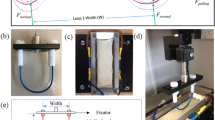Abstract
The adhesion of microbes to catheter surfaces is a serious problem and the resulting infections frequently lead to longer hospitalisation and higher risk for the patient. Several approaches have been developed to produce materials that are less susceptible to microbial colonisation. One such approach is the incorporation of photoactivated compounds, such as Toluidine Blue O (TBO), in the polymeric matrix resulting in ‘light-activated antimicrobial materials’. The insertion and removal of catheters can cause tissue damage and patient discomfort through frictional forces; hence the lubricity of a catheter material is also very important. In this work the tribological performance of silicone and polyurethane containing TBO and gold nanoparticles were evaluated using two different surfaces, the inner part of the aorta and the superior vena cava of sheep. Static and kinetic friction coefficients of these materials were measured using a tribometric device developed for in vitro applications using dry materials and those lubricated with blood. It was found that neither the preparation process nor the presence of TBO or gold nanoparticles, had an effect on the friction factors in comparison to those of untreated materials. In all cases, static and kinetic friction coefficients on aorta tissue were higher than those on vena cava due to higher surface roughness of the aorta. The presence of blood as a lubricant resulted in lower friction coefficients.


Similar content being viewed by others
References
Rabinowicz E. Friction and wear of materials. New York: Wiley; 1965.
Greenwood JA. Contact of rough surfaces. In: Singer IL, Pollock HM, editors. Fundamentals of friction: macroscopic and microscopic processes. Dordrecht: Kluwer; 1992. p. 37–56.
Bowden F, Tabor D. The friction and lubrication of solids. Oxford: Clarendon Press; 1986.
Bhushan B. Introduction to tribology. New York: Wiley; 2002.
Amontons G. De la resistance caus’ee dans les machines. Me′moires de l’Acade′mie Royale. 1699;A:257–82.
Gao J, Luedtke WD, Gourdon D, Ruth M, Israelachvili JN, Landman U. Frictional forces and Amonton’s law: from the molecular to the macroscopic scale. J Phys Chem B. 2004;108:3410–25.
Persson BNJ, Tosatti E. Physics of sliding friction. Dordrecht: Kluwer Academic; 1996.
Stickler DJ, Lear JC, Morris NS, Macleod SM, Downer A, Cadd DH, et al. Observations on the adherence of Proteus mirabilis onto polymer surfaces. J Appl Microbiol. 2006;100:1028–33.
Ferrieres L, Hancock V, Klemm P. Specific selection for virulent urinary tract infectious Escherichia coli strains during catheter-associated biofilm formation. FEMS Immunol Med Microbiol. 2007;51:212–9.
Norwood DE, Gilmour A. The growth and resistance to sodium hypochlorite of Listeria monocytogenes in a steady-state multispecies biofilm. J Appl Microbiol. 2000;88:512–20.
Juan-Torres A, Harbarth S. Prevention of primary bacteraemia. Int J Antimicrob Agents. 2007;30S:S80–7.
Haa US, Chob YH. Catheter-associated urinary tract infections: new aspects of novel urinary catheters. Int J Antimicrob Agents. 2006;28:485–90.
Hetrick EM, Schoenfisch MH. Reducing implant-related infections: active release strategies. Chem Soc Rev. 2006;35:780–9.
Perni S, Piccirillo C, Pratten JR, Prokopovich P, Chrzanowski W, Parkin IP, et al. The antimicrobial properties of light-activated polymers containing methylene blue and gold nanoparticles. Biomaterials. 2009;30(1):89–93.
Perni S, Prokopovich P, Piccirillo C, Pratten JR, Parkin IP, Wilson M. Toluidine blue-containing polymers exhibit bactericidal activity when irradiated with red light. J Mater Chem. 2009;19:2715–23.
Jones DS, Garvin CP, Gorman SP. Relationship between biomedical catheter surface properties and lubricity as determined using textural analysis and multiple regression analysis. Biomaterials. 2004;25:1421–8.
Jones DS, Garvin CP, Gorman SP. Design of a simulated urethra model for the quantitative assessment of urinary catheter lubricity. J Mater Sci Mater Med. 2001;12:15–21.
Ho SP, Nakabayashi N, Iwasaki Y, Boland T, LaBerge M. Frictional properties of poly(MPC-co-BMA) phospholipid polymer for catheter applications. Biomaterials. 2003;24:5121–9.
D’Angelo E, Loring SH, Gioia ME, Pecchiari M, Moscheni C. Friction and lubrication of pleural tissues. Respir Physiol Neurobiol. 2004;142(1):55–68.
Takashima K, Shimomura R, Kitou T, Terada H, Yoshinaka K, Ikeuchi K. Contact and friction between catheter and blood vessel. Tribol Int. 2007;40:319–28.
Kazmierska K, Szwast M, Ciach T. Determination of urethral catheter surface lubricity. J Mater Sci Mater Med. 2008;19:2301–6.
Karaszkiewicz A. Contact width and contact pressure of o-seals. Przegl Mech. 1979;7:14–6, 25–6 (in Polish).
Triolo PM, Andrade JD. Surface modification and characterization of some commonly used catheter materials. II. Friction characterization. J Biomed Mater Res. 1983;17:149–65.
Homola AW, Israelachvili JN, McGuiggan PM, Lee ML. Fundamental experimental studies in tribology: the transition from interfacial friction of undamaged molecularly smooth surfaces to normal friction with wear. Wear. 1990;136:65–83.
Schwarz UD, Zworner O, Koster P, Wiesendanger R. Quantitative analysis of the frictional properties of solid materials at low loads. Carbon compounds. Phys Rev B. 1997;56:6987–96.
Blau PJ. Scale effect in steady-state friction. Tribol Trans. 1991;34:335–42.
Hurtado J, Kim K. Scale effect in friction of single-asperity contacts. 1. From concurrent slip to single-dislocation-assisted slip. II. Multiple-dislocations-cooperated slip. Proc R Soc Lond A. 1999;455:3363–400.
Johnson KE. Histology and cell biology. Baltimore, MD: Williams and Wilkins; 1991.
Stensballe J, Looms D, Nielsen PN, Tvede M. Hydrophilic-coated catheters for intermittent catheterisation reduce urethral micro-trauma: a prospective, randomised, participant-blinded, crossover study of three different types of catheters. Eur Urol. 2005;48:978–83.
Koga S, Ikeda S, Futagawa K, Sonoda K, Yoshitake T, Miyahara Y, et al. The use of a hydrophilic-coated catheter during trans-radial cardiac catheterization is associated with a low incidence of radial artery spasm. Int J Cardiol. 2004;96(2):255–8.
Acknowledgements
M.W., J.P. and I.P.P. thank the BBSRC for supporting this work through grant BB/E012310/1; I.P.P. thanks the Royal Society/Wolfson trust for a merit award.
Author information
Authors and Affiliations
Corresponding author
Rights and permissions
About this article
Cite this article
Prokopovich, P., Perni, S., Piccirillo, C. et al. Frictional properties of light-activated antimicrobial polymers in blood vessels. J Mater Sci: Mater Med 21, 815–821 (2010). https://doi.org/10.1007/s10856-009-3882-2
Received:
Accepted:
Published:
Issue Date:
DOI: https://doi.org/10.1007/s10856-009-3882-2




